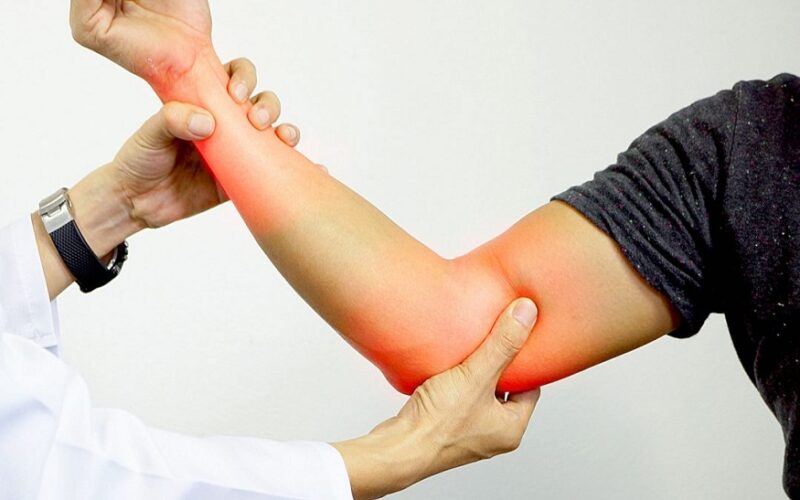What is Cubital Tunnel Syndrome? Cubital Tunnel Syndrome, also known as ulnar nerve entrapment, is a medical condition in which the ulnar nerve is either compressed or irritated, the most common site being at the elbow.
The ulnar nerve is a continuation of the medial cord of the brachial plexus that arises from the C8 and T1 of the nerve roots in the neck area of the body. Above the elbow region of the arm the ulnar nerve moves through the cubital tunnel to reach the lower part of the arm (below the elbow). Cubital tunnel is a roofed gap, made of tissues, between the Medial epicondyle of the humerus (the bone between shoulder and elbow) and olecranon of the ulna (the bone between elbow and hand). The ulnar nerve then divides into three branches- muscular branch, palmar cutaneous branch and dorsal cutaneous branch. The ulnar nerve is responsible for sensations and movements in the little finger, partial ring finger and the palm and the hand on the side of the little finger.
There are three major sites for the ulnar nerve entrapment. The entrapment may be between the two heads of the Flexor Carpi Ulnaris. The entrapment may be at the Arcade of Struthers which is an upper neurotic band exactly in the middle of the arm which connects the medial head of triceps and medial intermuscular septum. The entrapment may be between the Osborne’s ligament and the medial carpal ligament that is exactly at the cubital tunnel.
The main causes of Cubital Tunnel Syndrome
- With time the tissue of the cubital tunnel may get thicker which causes compression of the ulnar nerve.
- Bone spurs are unwanted bone projections along the bone’s edges. Bone spurs are also a common factor causing the condition. Bone spurs can be due to heterotopic ossification or osteophytes.
- Chronic compression over time with physical activities like intense exercise, sleeping with elbows bent, pressure on elbows while sitting or typing may snap or stretch the ulnar nerve.
- Tumours and ganglion cysts in the elbow can cause pressure in the ulnar nerve.
- Fracture of the elbow can cause unwanted pressure on the nerve. It is seen that fracture of medial epicondyle is common in children between the ages of 7 and 15. This may be the reason for cubital tunnel syndrome later in life.
Signs and Symptoms-
- Weak pinch and grasp- The patient is unable to pinch or grasp properly in the early offset of this condition.
- Paraesthesia- The little finger, ring finger or palm area may temporarily or permanently lose sensation or feel numbness. They may feel the pain as if they are pierced with pins or needles.
- Interosseous atrophy- Interosseous atrophy is the weakening of muscle. The palm and hand may weaken in this condition.
- Clawing and weakened grasp- Clawing of the little finger and ring finger is a symptom of this condition. The patient is unable to stretch those fingers or pull them together to form a fist.
- The patients may feel aching pain at the elbow also
Diagnosis-
- X-ray- X ray of the elbow is done. The x-ray is then studied to see if there is a fracture or bone spur. The doctor searches for arthritis in aging patients.
- Electromyogram (EMG)- This is a diagnostic procedure that helps in knowing the health of muscles and nerve cells. A narrow needle electrode is inserted in the muscle and electrode stickers are struck on skin. The machine then records and prints the results.
- Nerve Conduction Test- This test determines the pace at which nerves send signals. This can determine if there is a compression along the way. In this the doctor will place two electrodes at a distance from each other, in this case, one near the elbow (stimulating electrode) and other near the hand (recording electrode).
Treatment-
Many mild and moderate conditions can be treated without surgery. The physical therapist will consult you and program exercises accordingly. It is advised to put minimum strain on the affected hand. In some cases, an elbow pad may also be given to be worn by the patient. In other severe cases patients may have to go surgeries such as in-situ compression and nerve transposition surgery.
India is the home of medical knowledge and resources, thus it cannot be discounted when discussing the treatment of Cubital Tunnel Syndrome or any other health complications for that matter. Indian hospitals, particularly those in Mumbai and Bangalore, are the best when it comes to accurate diagnoses and treatments because of their reputation for medical tourism, experience, and comparatively high success rates. Not only that, but within India, the top tiered cities such as Bangalore, are known to offer top-notch healthcare infrastructure, while being affordable at the same time. Therefore, even if you look for the best orthopedic hospital in bangalore, you can rest assured that you will find good quality healthcare within budget.

